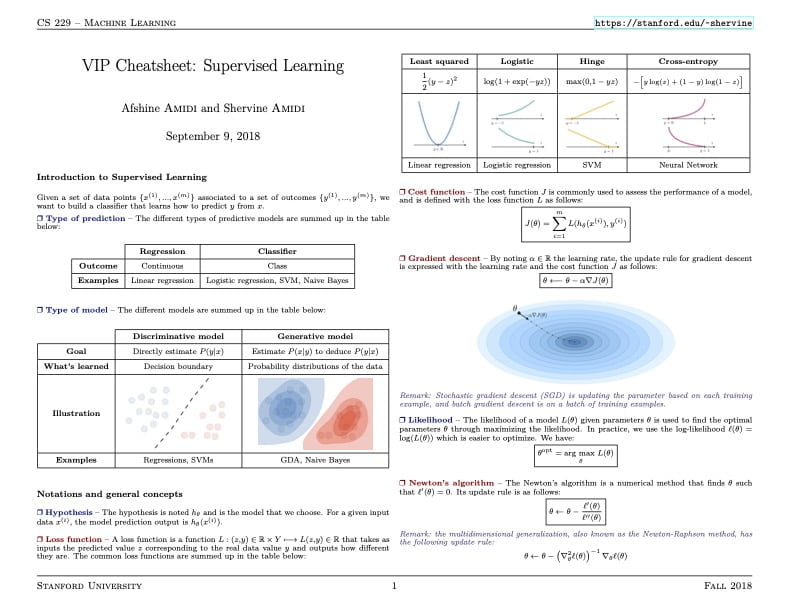
Supervised Learning is a type of ML where models are trained using labeled data & the algorithm learns from input-output pairs to make predictions or decisions. As a beginner in the field of machine learning, understanding supervised learning algorithms and their applications can be a bit overwhelming. To help you get started, we’ve created this ultimate cheat sheet that covers the most common supervised learning algorithms and their key aspects.
Table of Contents
Introduction
Supervised learning is a type of machine learning technique where the algorithm learns from labeled data to make predictions or decisions. In supervised learning, the data is labeled with the correct answers, and the algorithm’s task is to learn the mapping function between the input data and the desired output or target variable.
- Training Process:
- Labeled Data: It relies on a labeled dataset, which contains both input features and corresponding output labels.
- Mapping Relationship: The algorithm learns a mapping between the input and output data by observing examples from the labeled dataset.
- Prediction: Once trained, the model can predict output labels for new, unseen data based on the learned relationship.
- Examples:
- Imagine a shopping store dataset:
- Input Features: Gender, Age, Salary
- Output Label: Purchased (0 or 1, where 1 means the customer will purchase and 0 means they won’t)
- Or consider a meteorological dataset:
- Input Features: Dew Point, Temperature, Pressure, Relative Humidity, Wind Direction
- Output Label: Wind Speed
- Imagine a shopping store dataset:
- Training and Validation:
- During training, data is typically split into training (80%) and testing (20%) sets.
- The model learns from the training data, building its own logic.
- Various machine learning algorithms (such as linear regression, logistic regression, decision trees, and support vector machines) are used to construct the model.
- Supervisor or Teacher: In supervised learning, the presence of a “supervisor” or “teacher” guides the learning process, making it akin to how humans learn with guidance.
Top 10 Supervised Learning Algorithms
Classification Algorithms
1. Logistic Regression
- Binary classification algorithm
- Outputs probability of belonging to each class
- Applies the logistic sigmoid function to model the data
- Efficient and interpretable, but assumes linearity
2. Decision Trees
- Recursive partitioning algorithm
- Splits the data based on feature values
- Builds a tree-like model for classification or regression
- Easy to interpret, but can overfit if not pruned
3. Random Forest
- Ensemble learning method
- Constructs multiple decision trees on random subsets of data
- Combines the predictions of individual trees
- Robust to overfitting and handles high-dimensional data well
4. Support Vector Machines (SVMs)
- Determine which hyperplane is best for maximizing the margin between classes.
- Can handle high-dimensional data and non-linear decision boundaries
- Effective for binary classification, but can be extended to multi-class problems
5. Naive Bayes
- Probabilistic classifier based on Bayes’ theorem
- Assumes feature independence (naive assumption)
- Simple and efficient, but may perform poorly if the assumption is violated
Regression Algorithms
6. Linear Regression
- Simulates how independent and dependent variables are related to one another
- Finds the best-fitting line or hyperplane that minimizes the error
- Simple and interpretable, but assumes linearity
7. Decision Trees (Regression)
- Similar to classification trees, but predicts continuous values
- Splits the data based on feature values and outputs mean/median for each leaf
8. Random Forest (Regression)
- Ensemble of decision trees for regression tasks
- Combines the predictions of multiple trees to improve accuracy and reduce overfitting
9. Support Vector Regression (SVR)
- Extension of SVMs for regression tasks
- Finds the optimal hyperplane within a specified epsilon (ε) margin
10. KNN (k-Nearest Neighbors)
KNN (k-Nearest Neighbors) can be used for both supervised and unsupervised learning tasks.
- In supervised learning, KNN is commonly used for classification and regression problems.
- For classification, the algorithm predicts the class label of a new data point based on the majority class of its k nearest neighbors in the training set.
- For regression, the algorithm predicts the target value of a new data point by taking the average or median of the target values of its k nearest neighbors in the training set.
Ensemble Methods
1. Bagging (Bootstrap Aggregating)
- Trains multiple models on different subsets of the data (bootstrap samples)
- Combines the predictions of individual models to improve accuracy and stability
2. Boosting
- Iteratively trains weak models on the same data
- Gives more weight to misclassified examples in subsequent iterations
- Examples: AdaBoost, Gradient Boosting Machines (GBM)
Applications of Supervised Learning
- Classification: Spam detection, image recognition, credit approval
- Regression: Stock price prediction, sales forecasting, real estate valuation
- Sentiment analysis: Analyzing opinions and emotions in text data
- Fraud detection: Identifying fraudulent transactions or activities
- Recommendation systems: Suggesting products, movies, or content based on user preferences
If you want to learn more about top machine learning algorithms with their pros and cons then click here
Supervised Learning Cheat Sheet




Summary
In summary, supervised learning allows models to learn from labeled data, making accurate predictions based on the learned relationships. It’s widely used in fields like finance, healthcare, and marketing. This cheat sheet covers the most commonly used supervised learning algorithms and techniques. As a beginner, understanding the underlying concepts and applications of these algorithms will provide a solid foundation for further exploration in the field of supervised learning.
Remember, practice and hands-on experience are key to mastering these techniques. Happy learning!
Learn more about machine learning and other topics
- Unsupervised Learning
- Machine Learning Algorithms: How To Evaluate The Pros & Cons
- Machine Learning: A Quick Refresher and Ultimate Cheat Sheet
- Data Science Cheat Sheets
- Deep Learning Cheat Sheets
- Algebra and Calculus
- Supervised Learning by Google
